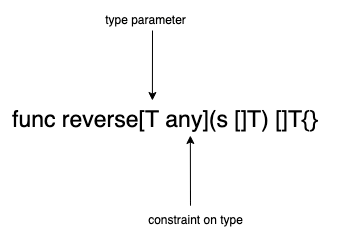The addition of generics is the most significant change to Go (formerly Golang) since its debut. The Go community has long been asking for generics as a feature since the inception of the language, and now it’s finally here.

Go generics’ implementation is very different from traditional implementations found in C++, while bearing similarities to Rust’s generics implementation — we’ll be taking a look at understanding generics in Go in this overview article.
To be able to use generics properly, one needs to understand what generics are and why they are required. Generics allow you to write code without explicitly providing specific data types they take or returns — in other words, while writing some code or data structure, you don’t provide the type of values.
These type values are instead passed later. Generics allow Go programmers to specify types later and avoid the boilerplate code.
The aim of generics is to reduce boilerplate code. For example, a reverse array function doesn’t require knowing the type of element of the array, but without generics, there is no type-safe method of representing this without repetition. You instead have to implement a reverse function for each type, which will create a huge amount of code that needs to be in sync with each type implementation maintained accordingly.
This problem is what is ultimately solved by generics.
constraints packageGo 1.18.0 introduces a new syntax for providing additional metadata about types and defining constraints on these types.
package main
import "fmt"
func main() {
fmt.Println(reverse([]int{1, 2, 3, 4, 5}))
}
// T is a type parameter that is used like normal type inside the function
// any is a constraint on type i.e T has to implement "any" interface
func reverse[T any](s []T) []T {
l := len(s)
r := make([]T, l)
for i, ele := range s {
r[l-i-1] = ele
}
return r
}

As you can see in the above image,[] brackets are used to specify type parameters, which are a list of identifiers and a constraint interface. Here, T is a type parameter that is used to define arguments and return the type of the function.
The parameter is also accessible inside the function. any is an interface; T has to implement this interface. Go 1.18 introduces any as an alias to interface{}.
The type parameter is like a type variable — all the operations supported by normal types are supported by type variables (for example, make function). The variable initialized using these type parameters will support the operation of the constraint; in the above example, the constraint is any.
type any = interface{}
The function has a return type of []T and an input type of []T. Here, type parameter T is used to define more types that are used inside the function. These generic functions are instantiated by passing the type value to the type parameter.
reverseInt:= reverse[int]
(Note: When a type parameter is passed to a type, it is called “instantiated”)
Go’s compiler infers the type parameter by checking the arguments passed to functions. In our first example, it automatically infers that the type parameter is int, and often you can skip passing it.
// without passing type
fmt.Println(reverse([]int{1, 2, 3, 4, 5}))
// passing type
fmt.Println(reverse[int]([]int{1, 2, 3, 4, 5}))
As you have seen in the above snippets, generics allows for reducing boilerplate code by providing a solution to represent code with actual types. Any number of type parameters can be passed to a function or struct.
Using type parameters in functions allows programmers to write code generics over types.
The compiler will create a separate definition for each combination of types passed at instantiation or create an interface-based definition derived from usage patterns and some other conditions which are out of the scope of this article.
// Here T is type parameter, it work similiar to type
func print[T any](v T){
fmt.Println(v)
}
Generics is very useful with special types, as it allows us to write utility functions over special types.
When creating a slice, only one type is required, so only one type parameter is necessary. The example below shows the usage for type parameter T with a slice.
// ForEach on slice, that will execute a function on each element of slice.
func ForEach[T any](s []T, f func(ele T, i int , s []T)){
for i,ele := range s {
f(ele,i,s)
}
}
The map requires two types, a key type and a value type. The value type doesn’t have any restraints but the key type should always satisfy the comparable constraint.
// keys return the key of a map
// here m is generic using K and V
// V is contraint using any
// K is restrained using comparable i.e any type that supports != and == operation
func keys[K comparable, V any](m map[K]V) []K {
// creating a slice of type K with length of map
key := make([]K, len(m))
i := 0
for k, _ := range m {
key[i] = k
i++
}
return key
}
Similarly, channels are also supported by generics.
Go allows defining structs with a type parameter. The syntax is similar to the generic function. The type parameter is usable in the method and data members on the struct.
// T is type parameter here, with any constraint
type MyStruct[T any] struct {
inner T
}
// No new type parameter is allowed in struct methods
func (m *MyStruct[T]) Get() T {
return m.inner
}
func (m *MyStruct[T]) Set(v T) {
m.inner = v
}
Defining new type parameters is not allowed in struct methods, but type parameters defined in struct definitions are usable in methods.
Generic types can be nested within other types. The type parameter defined in a function or struct can be passed to any other type with type parameters.
// Generic struct with two generic types
type Enteries[K, V any] struct {
Key K
Value V
}
// since map needs comparable constraint on key of map K is constraint by comparable
// Here a nested type parameter is used
// Enteries[K,V] intialize a new type and used here as return type
// retrun type of this function is slice of Enteries with K,V type passed
func enteries[K comparable, V any](m map[K]V) []*Enteries[K, V] {
// define a slice with Enteries type passing K, V type parameters
e := make([]*Enteries[K, V], len(m))
i := 0
for k, v := range m {
// creating value using new keyword
newEntery := new(Enteries[K, V])
newEntery.Key = k
newEntery.Value = v
e[i] = newEntery
i++
}
return e
}
// here Enteries type is instantiated by providing required type that are defined in enteries function func enteries[K comparable, V any](m map[K]V) []*Enteries[K, V]
Unlike generics in C++, Go generics are only allowed to perform specific operations listed in an interface, this interface is known as a constraint.
A constraint is used by the compiler to make sure that the type provided for the function supports all the operations performed by values instantiated using the type parameter.
For example, in the below snippet, any value of type parameter T only supports the String method — you can use len() or any other operation over it.
// Stringer is a constraint
type Stringer interface {
String() string
}
// Here T has to implement Stringer, T can only perform operations defined by Stringer
func stringer[T Stringer](s T) string {
return s.String()
}
New additions to Go allow predefined types like int and string to implement interfaces that are used in constraints. These interfaces with predefined types can only be used as a constraint.
type Number {
int
}
In earlier versions of the Go compiler, predefined types never implemented any interface other than interface{}, since there was no method over these types.
A constraint with a predefined type and method can’t be used, since predefined types have no methods on these defined types; it is therefore impossible to implement these constraints.
type Number {
int
Name()string // int don't have Name method
}
| operator will allow a union of types (i.e., multiple concrete types can implement the single interface and the resulting interface allows for common operations in all union types).
type Number interface {
int | int8 | int16 | int32 | int64 | float32 | float64
}
In the above example, the Number interface now supports all the operations which are common in provided type, like <,>, and + — all the algorithmic operations are supported by the Number interface.
// T as a type param now supports every int,float type
// To able to perform these operation the constrain should be only implementing types that support arthemtic operations
func Min[T Number](x, y T) T {
if x < y {
return x
}
return y
}
Using a union of multiple types allows the performing of common operations supported by these types and writing code that will work for all types in union.
Go allows creating user-defined types from predefined types like int, string, etc. ~ operators allow us to specify that interface also supports types with the same underlying types.
For example, if you want to add support for the type Point with the underlining type int to Min function; this is possible using ~.
// Any Type with given underlying type will be supported by this interface
type Number interface {
~int | ~int8 | ~int16 | ~int32 | ~int64 | ~float32 | ~float64
}
// Type with underlying int
type Point int
func Min[T Number](x, y T) T {
if x < y {
return x
}
return y
}
func main() {
// creating Point type
x, y := Point(5), Point(2)
fmt.Println(Min(x, y))
}
All predefined types support this approximated type — the ~ operator only works with constraints.
// Union operator and type approximation both use together without interface
func Min[T ~int | ~float32 | ~float64](x, y T) T {
if x < y {
return x
}
return y
}
Constraints also support nesting; the Number constraint can be built from the Integer constraint and Float constraint.
// Integer is made up of all the int types
type Integer interface {
~int | ~int8 | ~int16 | ~int32 | ~int64
}
// Float is made up of all the float type
type Float interface {
~float32 | ~float64
}
// Number is build from Integer and Float
type Number interface {
Integer | Float
}
// Using Number
func Min[T Number](x, y T) T {
if x < y {
return x
}
return y
}
constraints packageA new package with a collection of useful constraints has been provided by the Go team — this package contains constraints for Integer, Float etc.
This package exports constraints for predefined types. Since new predefined types can be added to language, it is better to use constraints defined in the constraints package. The most important one of these is the [Ordered](https://pkg.go.dev/golang.org/x/exp/constraints#Ordered) constraint. It defines all the types that support >,<,==, and != operators.
func min[T constraints.Ordered](x, y T) T {
if x > y {
return x
} else {
return y
}
}
Generics are not a replacement for interfaces. Generics are designed to work with interfaces and make Go more type-safe, and can also be used to eliminate code repetition.
The interface represents a set of the type that implements the interface, whereas generics are a placeholder for actual types. During compilation, generic code might be turned into an interface-based implementation.
This article covers how to define a type parameter and how to use a type parameter with existing constructs like functions and structs.
We also looked at union operators and new syntax for implementing an interface for predefined type, as well as using type approximation and using generics with special types like structs.
Once you have all the basic knowledge with a strong foundation, you can dive deeper into more advanced topics; like using generics with type assertions.
Generics will serve as the building blocks for a great library similar to lodash from the JavaScript ecosystem. Generics also help in writing utility functions for Map, Slice, and Channel because it is difficult to write functions that support every type without the reflect package.
Here are some code samples I have written or collected from the original drafts for generics for your convenience.
Install LogRocket via npm or script tag. LogRocket.init() must be called client-side, not
server-side
$ npm i --save logrocket
// Code:
import LogRocket from 'logrocket';
LogRocket.init('app/id');
// Add to your HTML:
<script src="https://cdn.lr-ingest.com/LogRocket.min.js"></script>
<script>window.LogRocket && window.LogRocket.init('app/id');</script>
Hey there, want to help make our blog better?
Join LogRocket’s Content Advisory Board. You’ll help inform the type of content we create and get access to exclusive meetups, social accreditation, and swag.
Sign up now
Learn how to integrate MediaPipe’s Tasks API into a React app for fast, in-browser object detection using your webcam.

Integrating AI into modern frontend apps can be messy. This tutorial shows how the Vercel AI SDK simplifies it all, with streaming, multimodal input, and generative UI.

Interviewing for a software engineering role? Hear from a senior dev leader on what he looks for in candidates, and how to prepare yourself.

Set up real-time video streaming in Next.js using HLS.js and alternatives, exploring integration, adaptive streaming, and token-based authentication.